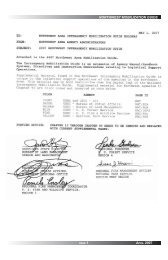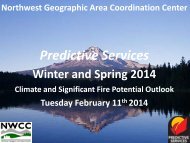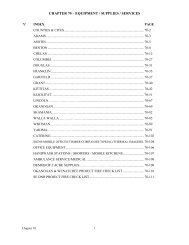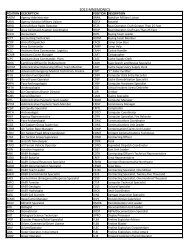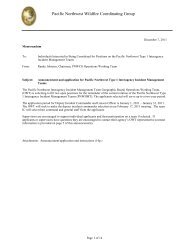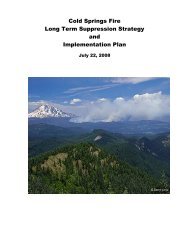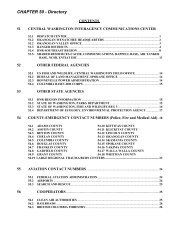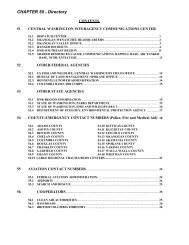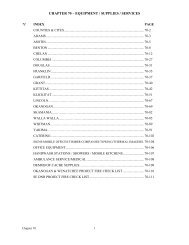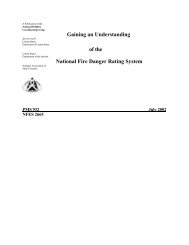Charts for interpreting wildland fire behavior characteristics - NWCC
Charts for interpreting wildland fire behavior characteristics - NWCC
Charts for interpreting wildland fire behavior characteristics - NWCC
You also want an ePaper? Increase the reach of your titles
YUMPU automatically turns print PDFs into web optimized ePapers that Google loves.
<strong>fire</strong> analysis.<br />
Expected change in <strong>fire</strong> <strong>behavior</strong> with a change<br />
in fuel type.<br />
Prescribed<strong>fire</strong><br />
Fire <strong>characteristics</strong> required to achieve specific<br />
burn objectives.<br />
Fire <strong>behavior</strong> expected under a range of weather<br />
conditions.<br />
Behavior of an escaped <strong>fire</strong>.<br />
Conditions that will require using ignition<br />
patterns to draw the <strong>fire</strong> and produce the desired<br />
intensity.<br />
Behavior of strip <strong>fire</strong>s-bracketed by plotting the<br />
<strong>behavior</strong> of a backing <strong>fire</strong> and a free-burning<br />
head <strong>fire</strong>.<br />
Long-range planning<br />
Variation of <strong>fire</strong> <strong>behavior</strong> between planning units<br />
under the same weather conditions.<br />
Effect of a change in fuel type on <strong>fire</strong> <strong>behavior</strong>.<br />
Application of Fire Behavior <strong>Charts</strong><br />
EXAMPLE: FIRE PRESCRIPTIONS<br />
Successful prescribed burning requires planning.<br />
Fischer (1978) propbses a four-point <strong>fire</strong> use plan and<br />
report: treatment area and objectives, <strong>fire</strong> prescription,<br />
Part 2 - Fire Prescription<br />
2.1 Treatment Specifications<br />
2.11 Desired Accomplishment<br />
- Kiii shrubs and trees C5" D.B.H. without kiillng the<br />
overstory of western larch.<br />
- Expose mineral soils over 60% of the area<br />
- Reduce duff by 86%.<br />
2.12 Desired Fire Behavior<br />
- The fiame iength must be iess than 4 feet to ensure that<br />
less than 60% of the crowns will be scorched, there<strong>for</strong>e<br />
aliowlng the larch to survive.<br />
- Due to dlscontinulty of fuels, a head flre wlth a flame<br />
length of at least 2 feet IS required to achleve a unl<strong>for</strong>m<br />
burn pattern<br />
- The fiame iength should be iess than 4 feet to reduce the<br />
risk of torching and spot <strong>fire</strong>s. The burn area is within<br />
a mile of some 2.year old logging siash. if a spot fre<br />
occurs in the siash, it wiii require pumpers and possibiy<br />
retaidant <strong>for</strong> control.<br />
- Under the burning conditions that are required to meet<br />
desired duff reduction objectives, a free-burning, <strong>for</strong>ward.<br />
spreadng <strong>fire</strong> would make torching. crowning, and spottirig<br />
probable. Strip head<strong>fire</strong>s will be used to keep the <strong>fire</strong><br />
<strong>behavior</strong> wthin the required range.<br />
2.13 Required Environmental Conditions<br />
Relative Humidity - 20.30%<br />
Temperature - 70-80 F<br />
Windspeed (midflame) - N-NW - 3-7<br />
1.H Fuel Moisture - 10.14%<br />
10.H Fuel Moisture - 12.14%<br />
Live Fuel Moisture - 75.125%<br />
Duff Moisture - 50%<br />
Figure 4.-The <strong>fire</strong> prescription part of a <strong>fire</strong><br />
use plan and report.<br />
burning plan, and report. The <strong>fire</strong> prescription portion<br />
includes a section on <strong>fire</strong> <strong>behavior</strong> and associated en-<br />
vironmental conditions desired to meet burn objectives.<br />
Increasingly specific <strong>fire</strong> management objectives have<br />
created a need <strong>for</strong> more quantitative descriptions of <strong>fire</strong><br />
<strong>behavior</strong>. Rate of spread described as fast or slow, or<br />
<strong>fire</strong> intensity as hot or cool, is often not adequate. The<br />
four values plotted on the <strong>fire</strong> cliaracteristics chart<br />
describe aspects of <strong>fire</strong> <strong>behavior</strong> that are important in<br />
both <strong>fire</strong> control and <strong>fire</strong> effects considerations. Flame<br />
length and <strong>fire</strong>line intensity are directly related Lo the<br />
effectiveness of control <strong>for</strong>ces. Many prescribed burns<br />
are conducted under conditions that produce flame<br />
lengths less than 3 feet. Rothermel and Deeming (1980)<br />
have suggested that <strong>fire</strong>line intensity be correlated to<br />
<strong>fire</strong> effects in the flames or in the convection column,<br />
and heat per unit area be correlated to <strong>fire</strong> effects near<br />
the base of the <strong>fire</strong> in the duff and litter. Fire <strong>behavior</strong><br />
can be quantified on a <strong>fire</strong> characteristic chart without<br />
dwelling on tables and numbers. An example of a sec-<br />
tion of a <strong>fire</strong> use plan and report and the associated <strong>fire</strong><br />
<strong>behavior</strong> chart are shown in figures 4 and 5.<br />
300<br />
250<br />
200<br />
-<br />
-.<br />
-<br />
FIRE BEHAVIOR<br />
Fire Characteristics Chart<br />
4 s Fee - bumin he~dGre<br />
4<br />
B : Backin Cire<br />
9<br />
c: Desired &.;-re<br />
0 500 1000 1500 2000<br />
HEAT PER UNIT AREA, BTUI d2<br />
Figure 5.-Use of a <strong>fire</strong> <strong>characteristics</strong> chart<br />
to illustrate the desired <strong>fire</strong> <strong>behavior</strong> portion<br />
of the prescription given in figure 4.<br />
<strong>behavior</strong>




